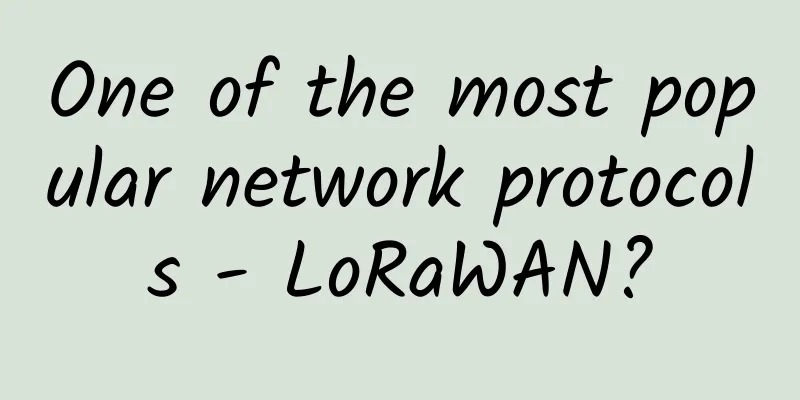One of the most popular network protocols - LoRaWAN?

|
Communication and network protocols are an essential part of Internet of Things (IoT) applications. Without them, it would be impossible to interconnect devices and exchange data to create smart applications. Fortunately, there are multiple options for such protocols, with different technical features and utilities, each suitable for specific domains and use case scenarios. Official definition of LoRaWANBefore we delve into the definition of the protocol, let’s first understand some important facts about its origins. LoRaWAN was developed by the LoRa Alliance, which was founded in 2015 and has more than 500 members, including IoT product and service providers, manufacturers and telecommunications companies. LoRaWAN was developed in 2009 by the founders of Grenoble-based Cycléo, which was acquired by Semtech in 2012. Three years later, Semtech founded the LoRa Alliance, an industry association that now has more than 500 members, including IoT product and service providers, manufacturers and telecommunications companies. It is through this ecosystem that Semtech promotes the protocol and develops its use worldwide. In addition, LoRaWAN is a medium access control (MAC) layer protocol that became an officially recognized low-power wide-area network (LPWAN) standard by the International Telecommunication Union (ITU) in 2021. The official definition released by the LoRa Alliance is as follows: “The LoRaWAN® specification is a low-power, wide-area (LPWA) networking protocol designed to wirelessly connect battery-powered “things” to the Internet in regional, national or global networks and targets key Internet of Things (IoT) requirements such as two-way communications, end-to-end security, mobility and localized services.” LoRaWAN combines the wireless interconnectivity of IoT devices and networks while retaining important features for end users. Simplified LoRAWAN definition:The following line-by-line explanation of this definition is given in detail. “The LoRaWAN® specification is a low-power wide-area (LPWA) network protocol” – LoRaWAN is a communication protocol that has low energy requirements but supports larger areas. “Designed to wirelessly connect battery-powered ‘things’ to the Internet in regional, national or global networks” – It is capable of wirelessly interconnecting IoT battery-powered devices via the Internet, supporting networks from local to global levels. "and targets key Internet of Things (IoT) requirements such as two-way communication, end-to-end security, mobility, and localized services." - As a protocol, it aims to further enhance important IoT requirements such as two-way communication and data transmission, secure data transmission from one device to another, support portability, and assist in real-time tracking capabilities. Technical characteristics of LoRaWANThe basis of its technical specifications is the connection with LoRa, a wireless modulation scheme developed by Semtech. Specifically, due to its MAC characteristics, it acts as an extension of LoRa and deploys supported nodes into the LoRa system in a star topology. The main features of LoRaWAN are as follows:
Pros and Cons of LoRaWANConsidering the technical characteristics of the protocol and the functions it defines, we can look at its advantages and disadvantages. As can be seen from its definition and technical characteristics, one of the biggest advantages of the LoRaWAN protocol is its low power requirements and increased battery capacity, as well as long-range capabilities. This makes it a perfect solution for the deployment of IoT technologies and smart solutions. The protocol works well indoors through dedicated networks and allows the use of sensors to collect data from underground devices in some cases. In fact, the protocol supports both public and private networks. The protocol also supports real-time tracking services and geolocation without the need for a GPS chipset. However, it also has some disadvantages: Due to the limited data rate, it is not suitable for large payloads. It also cannot support multimedia files such as audio or video. Another factor to consider is that, depending on the installed sensor, there may sometimes be a slight delay. In fact, for Class C sensors, the command (downlink) is sent immediately after programming and there is no delay. For Class A sensors, the command is executed after the sensor sends a message to the server. Here are some use cases for A&C class devices:
Finally, depending on the use case and the type of frequencies used, additional setup may be required to avoid potential interference. SummarizeThe LoRaWAN communication protocol is a long-range, low-power wireless protocol designed to connect objects to the Internet, such as IoT sensors in environments where traditional cellular connectivity is not an option or is costly. Due to its longevity and cost, it is an effective and sustainable solution for smart buildings that can improve a building's energy performance, comfort, air quality, security or equipment management. |
<<: Why bridging 5G and Wi-Fi is key to a connected future
Recommend
ExtraVM 30% off, AMD Ryzen+NVMe+1Gbps unlimited traffic, multiple computer rooms in Los Angeles and other places
ExtraVM recently launched a promotion on WHT, off...
DiyVM: 50 yuan/month-dual core, 2G memory, 50G hard disk, 2M, Hong Kong CN2 data center
DiyVM is a long-established Chinese hosting compa...
Five hybrid video conferencing tips for effective collaboration
[[417444]] When Pixoul, a Dallas-based web design...
AI and Wi-Fi 6: Driving the Revolution in Home Wi-Fi
As fixed networks enter the F5G (fifth generation...
Huawei Network Energy "Innovation" on the Road
[51CTO.com original article] Introduction: "...
The future of work: In a hybrid world, office space cuts are coming
[[440952]] As the pandemic continues to spread, m...
Five things you need to know about the current state of 5G
5G is a rare combination of national will and mar...
Researchers transform 5G networks into IoT power grids
According to foreign media, researchers from the ...
Senhua Yiteng launches CDN intelligent service management platform
Adhering to the service-first concept, Senhua Yit...
Ministry of Industry and Information Technology: By 2023, the penetration rate of 5G individual users will exceed 40% and the number of users will exceed 560 million
[[410991]] Ministry of Industry and Information T...
The Q1 quarterly reports of the three major operators are released, and mobile customers are losing
Recently, the first quarter results of the three ...
Justhost: 20% off all VPS, 200M unlimited data, monthly payment from $1.34 in Russian data center
Justhost.ru is a Russian hosting company founded ...
Are you still pinging? 7 advanced methods to help you quickly test port connectivity
Ping is a command tool for checking network conne...
China Unicom: 5G package users reach 113 million
Recently, China Unicom officially announced its 2...
The impact of the novel coronavirus on remote networking
As the new coronavirus spreads widely, many compa...









